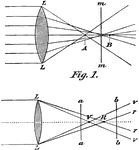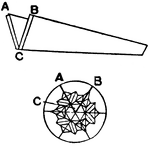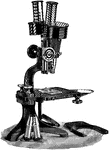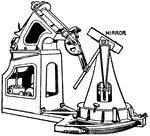Clipart tagged: ‘optics’

Aberration
"In optics, a deviation in the rays of light when unequally refracted by a lens or reflected…
Micrographic Apparatus with Camera and Microscope
An apparatus used to photograph images in a light microscope. The long camera is connected to the eye…
Optical Position and Size of Image Through Lens in Front of Eye
The illustration of putting lenses in front of the eye. The focal point of the image is reflected into…
Kaleidoscope
A kaleidoscope is an optical instrument invented by Brewster about 1815. It became very popular as a…

Mirrors in a Kaleidoscope
This illustration shows the arrangement of mirrors in a kaleidoscope (AC and BC), and the patterns formed.

Huyegenian Eyepiece Diagram Showing Lens Refraction
"They have also a shorter focus for red, and a longer one for blue, and thus magnify the red image more…

Ramsden Eyepiece Lens Refraction Diagram
"If the real image produced by the objective coincides with the collective lens, only the inclination…

Convex Lens
"When the object is at a long distance from the lens, the image formed is smaller than the object, and…
Light Correction of Blue and Red Lights using Spherical Lens
"Showing a system with chromatic difference of spherical aberration. O" ₌ image of O for red light;…

Baker Demonstration Light Microscope with Mirror Reflecting Light Source
A Baker demonstration light microscope illustrating the different parts of the microscope. The eyepiece…

Swift Stephen's Binocular Microscope with Mirror Reflecting Light Source
A swift Stephenson's Binocular Microscope with a mirror reflecting light source. The microscope has…

Entocentric Transmission in Compound Microscope Appear Images Larger or Smaller
An illustration of entocentric transmission of a compound microscope. The series of light refracted…

Greenough's Binocular Light Compound Microscope with Mirror Reflecting Light Source
A Greenough's binocular light microscope. The microscope has two eyepieces to view the sample with both…

Hypercentric Transmission in Microscopic Objective
"The intersection of the principal rays lies in front of the object, and consequently objects in front…

Leitz Micrometer Adjustment Screw for Microscope
An adjustment screw diagram used to raise or lower microscope slightly. The series of screw and springs…

Petrographical Light Microscope with Mirror and Eyepieces
A petrographic light microscope used to identify thin layered rocks and minerals. The microscope have…
Ray Transmission in Compound Microscope with a Positive Ocular
"The image produced by a microscope formed of two positive systems is inverted, the objective L1 tracing…
Ray Transmission in Compound Microscope with a Negative Eyepiece
An illustration of a compound microscope that produces upright image using negative eyepiece. The image…
Swift and Son Micrometer Adjustment Lever for Microscope
"The long lever D is pressed to one side by the screw F, and is thus turned round the in E. On the tube…

Microscope Mirror Illumination by Light Reflection
A light reflection diagram of a light microscope using a mirror. The mirror is used in a microscope…

Abbe Microscope Mirror Illumination by Light Reflection with Condenser
Illustration showing Abbe illuminating apparatus with condenser. The mirror, m, reflects light from…

Opera Glass
Opera glasses, also known as theater binoculars or Galilean binoculars, they are compact, low power…
Position and Size of Image for Eye Optics
An illustration of the position and the size of the image viewed by the eye. The eye approximates the…

Optical Position and Size of Image Through Magnifying Glasses
"If y be the object the image appears to a normal eye situated behind the system L with passive accommodation…

Optical Position of Diaphragms using Lens
"The intersection of the principal rays in this case lies in the middle of the entrance pupil or of…

Porro Prism
Double Porro prism systems are used in small optical telescopes to re-orient an inverted image, and…

Rotator
"In photometry (measure of light), a mounting for an incandescent lamp ... Rotator. The lamp to be tested…

Siderostat
"An instrument described by Foucault for transmitting a beam of light along the optical axis of a fixed…

Virtual Image Formed on Spherical Surface
"O' is the virtual image of O formed at a spherical surface of centre C and radius CS." —Encyclopaedia…

Large Dissecting Stand with Magnification Eyepiece Mirror Reflecting Light Source
A large dissecting stand with magnification eyepiece and mirror reflecting the light source. The stand…


